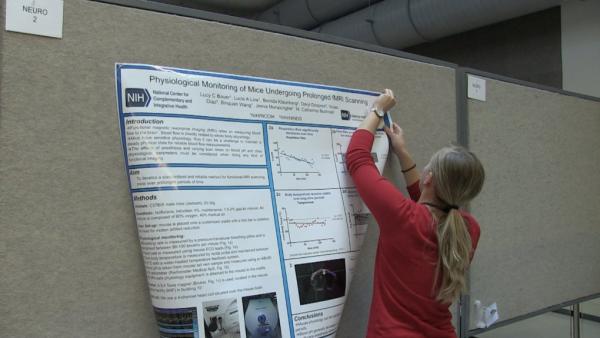Inside NIH’s Research Festival
As I trekked along the manicured sidewalk of Convent Drive, heading toward Building 10, I felt the now-familiar weight of the poster tube hanging over my shoulder. Inside that poster tube was, as the name implies, a scientific poster with which I was extremely familiar. My calves burned underneath the intensity of my power walk, as I remained calm and ready to present my project about mice undergoing anesthesia.

Hanging up an unwieldy poster requires a rare combination of skill and focus.
When I stepped foot onto the pristine floors of the FAES terrace, I recalled the poster session I had been to the previous afternoon. It was the one showcasing the work of the Scientific Directors… or it was showcasing the table of cookies and brownies they baked in competition? I can’t quite recall.
Either way, I remember the outstanding presentation by Dr. Catherine Bushnell about TMS. What is TMS, you ask? TMS stands for transcranial magnetic stimulation. Dr. Bushnell was showing her lab’s work about the effects of stimulating certain areas on the brain in relation to how we respond to different stimuli. Not only did her poster showcase interesting research, but Dr. Bushnell also included a demonstration of her work. Wielding a paintbrush and a two-point discrimination/poking device, Dr. Bushnell invited curious participants to experience her science firsthand.
When I visited her poster, Dr. Bushnell explained to me research from her lab showing different responses to being brushed across the skin quickly or more slowly, and how stimulating different parts of the brain via magnetic stimulation changes the way that brushing is experienced. Through her demonstration, I got to take part in the poster’s research with determining how brush stroke speed created different sensory responses. Generally, a slower brush stroke is more pleasant, and a faster brush stroke is neutral. This is because different sets of neurons respond to these specific brushing frequencies. When TMS gets involved, one can imagine how stimulating neurons in the brain might change those normal responses.
Next, I was poked several times with the two-point discrimination meter. This tool sounds very specialized, and it is, but it is by no means fancy. All this is is a small, stick-like device with two pointy ends that can be adjusted to be far apart, very close, or come together. Why make such a thing? This is a tool used to determine whether or not you can tell the difference between being touched by two separate things simultaneously or if you think you’re only being touched by one thing. Intuitively, one can surmise that it gets more difficult to discern whether it’s one point or two the closer together the points get. How did I do in determining one spot or two? That is not a necessary detail to divulge. Suffice it to say, I learned a lot at this poster presentation.

At one of the poster sessions where I was not presenting, I took the opportunity to interview Dr. Brenda Klaunberg of the NIH Mouse Imaging Facility (who happened to be wearing the coolest hat ever) for a video about the Research Festival.
So with all of this fresh in my mind, was I ready for my presentation? Absolutely! Since I am on my way to becoming a seasoned poster-presenting professional (links to old blog posts here and here), I was eager and at ease. I was a bit worried that no one would come to my presentation due to the fact that it was on a Friday afternoon. However, none of my fears were met, only assuaged. Indeed, as I earnestly stood at my poster, I gratefully entertained many visitors whose critical minds offered improvements on the work I’d shown. One particularly helpful commenter had questions about my statistics, and we were able to discuss different statistical approaches to my data.
All in all, I was honored to have participated in this annual event. With intramural programs in 24 Institutes and Centers represented, I savored the rare opportunity to see the diverse array of work done on the NIH campus. This sentiment was perfectly captured by the theme of this year’s festival: “A Celebration of Intramural Science.”
Related Blog Posts
This page was last updated on Monday, January 29, 2024
